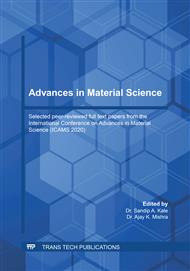[1]
IS:9013,(1978), Indian Standard method of making, curing and determining compressive strength of accelerated-cured concrete test specimens,, Bureau of Indian Standards, New Delhi, India.
Google Scholar
[2]
Zou, C., Long, G., Ma, C., and Xie, Y., Effect of subsequent curing on surface permeability and compressive strength of steam-cured concrete,, Construction and Building Materials, vol. 188, pp.424-432, (2018).
DOI: 10.1016/j.conbuildmat.2018.08.076
Google Scholar
[3]
Gonzalez-Corominas, A., Etxeberria, M., and Poon, C. S., Influence of steam curing on the pore structures and mechanical properties of fly-ash high performance concrete prepared with recycled aggregates,, Cement and Concrete Composites, vol. 71, pp.77-84, (2016).
DOI: 10.1016/j.cemconcomp.2016.05.010
Google Scholar
[4]
Hanif, A., Kim, Y., Lee, K., Park, C., and Sim, J., Influence of cement and aggregate type on steam-cured concrete – an experimental study,, Magazine of Concrete Research, vol. 69, pp.694-702, (2017).
DOI: 10.1680/jmacr.17.00015
Google Scholar
[5]
Tan, K. and Gjorv, O. E., Performance of concrete under different curing conditions,, Cement and Concrete Research, vol. 26, pp.355-361, (1996).
DOI: 10.1016/s0008-8846(96)85023-x
Google Scholar
[6]
Jeyalakshmi, R., Rajamane, N., and Dheeraj, Use of Nano Silica for improvement of porous fly ash and silica fume mortars,, International Journal of ChemTech Research, vol. 7, pp.1132-1139, (2014).
Google Scholar
[7]
Limbachiya, M. C., Leelawat, T., and Dhir, R. K., Use of recycled concrete aggregate in high-strength concrete,, Materials and Structures, vol. 33, pp.574-580, (2000).
DOI: 10.1007/bf02480538
Google Scholar
[8]
Sastri, M. V. S. S., Jagannadha Rao, K., and Bhiksma, V., Estimation of Compressive Strength of Concrete by testing the Pozzolanic Reactions of Blended Cement Mortars using Bolomey's Equation,, International Journal of Recent Technology and Engineering (IJRTE), vol. 8, pp.6525-6534, (2019).
DOI: 10.35940/ijrte.c5217.098319
Google Scholar
[9]
Limbachiya, M., Meddah, M. S., and Ouchagour, Y., Use of recycled concrete aggregate in fly-ash concrete,, Construction and Building Materials, vol. 27, pp.439-449, (2012).
DOI: 10.1016/j.conbuildmat.2011.07.023
Google Scholar
[10]
Priyanka, Musaib, and MehrajBhat, Effect of fly ash, silica fume and recycled aggregate on the compressive strength of concrete,, International Journal of Research in Engineering & Advanced Technology, vol. 3, pp.76-80, (2015).
Google Scholar
[11]
Jagannadha Rao, K., Mujeeb, M. A., and Sastri, M. V. S. S., Behavior of Ternary Blended Concrete with Fly Ash and Silica Fume,, IUP Journal of Structural Engineering, vol. 7, (2014).
Google Scholar
[12]
IS:12269,(2013), Specification for ordinary Portland cement, 53 grade (first revision),, Bureau of Indian Standards, New Delhi, India.
Google Scholar
[13]
Jagannadha Rao, K., Keerthi, K., and Vasam, S., Acid resistance of quaternary blended recycled aggregate concrete,, Case Studies in Construction Materials, vol. 8, pp.423-433, (2018).
DOI: 10.1016/j.cscm.2018.03.005
Google Scholar
[14]
IS:383,(2016), Coarse and fine aggregate for Concrete - Specification (Third Revision),, Bureau of Indian Standards, New Delhi, India.
Google Scholar
[15]
IS:10262,(2009), Concrete Mix Proportioning -Guidelines (First Revision),, Bureau of Indian Standards, New Delhi, India.
Google Scholar


